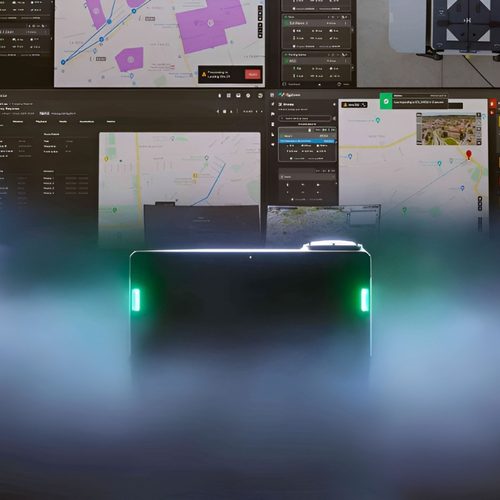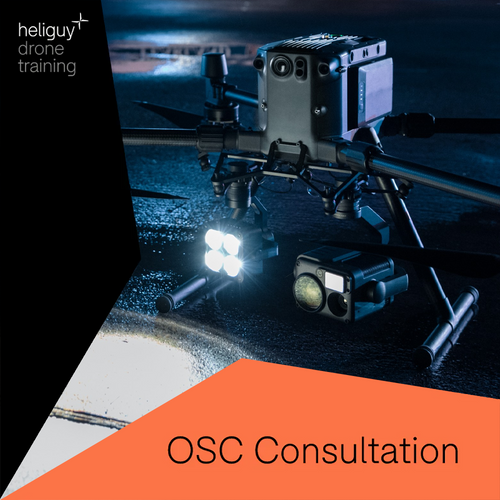
- Nitin Gupta, Founder and CEO of drone autonomy software platform FlytBase, encourages organisations to start using the DJI Dock now, instead of waiting for BVLOS drone laws to catch up;
- He encourages early Dock adoption so that users can take time to integrate it into their workflows and start collecting data to build a safety case for more complex operations - or risk delaying opportunities to scale;
- He says a client in the USA secured a BVLOS waiver after deploying it in a VLOS capacity to prove the use case and safety case;
- FlytBase software - compatible with DJI Dock - integrates multiple safety features for automated and remote drone deployment. FlytBase clients across eight different countries have secured BVLOS approvals;
- heliguy™ has an in-house OSC (Operating Safety Case) consultancy and can help organisations build a detailed safety case for complex operations. The consultancy has already helped drone programmes secure permissions for extended line of sight flights.
Organisations should integrate the DJI Dock into their workflows now and not wait for regulations to catch up, the CEO of an industry-leading drone autonomy software platform has said.
Speaking at the UK's first official DJI Dock demonstration, staged by heliguy™, Nitin Gupta, of FlytBase, said that adopting the technology early would give drone programmes a head-start in understanding how it can benefit their operations.

It would also enable them to begin collecting valuable data to build a detailed safety case to persuade regulators to unlock more ambitious permissions, such as beyond visual line of sight (BVLOS) flights for specific use cases, or be best-placed to apply for and conduct BVLOS operations when regulations allow.
Find out more about building a detailed safety case and how heliguy™ can help you, including in-house OSC consultancy.
In one example, Mr Gupta said that a FlytBase client in the USA began dock operations in a VLOS capacity, amassed hundreds of flying hours to build a portfolio which proved mission safety, and subsequently obtained a waiver to facilitate automated BVLOS deployments. The client has since scaled its drone-in-a-box operations to additional sites.
FlytBase clients across eight different countries have managed to secure BVLOS approvals.
In the UK, standardised BVLOS operations - especially in uncontrolled airspace - are at a fairly embryonic stage, but work is ongoing to progress this. And the launch of a public consultation addressing competency requirements in the Specific Category includes the future standards for BVLOS operations.
"The biggest challenge we see right now is from the regulatory side, such as BVLOS, but my recommendation to all of our partners and customers is, let's not wait for the regulations to be in place, let's get started now," said Mr Gupta, whose company has been specialising in docking station software for the last three years.

He continued: "Our customers often have concerns around regulations and they initially believe that the regulations need to be in place before they can utilise this technology. However, after some discussions, most of the customers realise they need to start using this technology right away.
"It takes time to complete your workflow integrations, to understand how this works, and how this scales. The integration and your own understanding of the technology will take time, so it is important to get started now.
"This also helps to collect data to build a safety case to increase the envelope, gradually expand, and push for more and more. Unless we start doing all of these things now, it will take longer to scale."
Operational Benefits
While the Dock is best utilised as an automated and remote BVLOS tool, there are operational benefits of deploying it in a VLOS capacity - at least initially.

These include:
- Huge value in planning, saving, and repeating missions remotely on-demand, helping with accurate and repeatable data collection;
- Eliminate numerous on-site tasks for a pilot, including charging/swapping batteries (the Dock automatically charges at the station, going from 10-90% in 25 minutes); automatic updates, remote flight planning, and instantaneous data offload/upload (data straight to the cloud, instead of requiring manual removal of an SD Card).
- Centralisation of data enables remote and real-time situational awareness from anywhere in the world, improving communication and visibility.
Build A Safety Case
And then there's the benefits of using these Dock flights to build a use case to push for permissions for more complex missions, such as achieving BVLOS operations.
Nitin said: "Integrating the Dock into your workflows takes time, so by the time you have done all of this work, the regulations are likely to be in place anyway.

"But, in most cases, if you go to the regulators and present a safety case, it is possible, almost in every country, to build a safety case to understand their concerns and maybe using a geofence or an altitude limit, we are able to find a way to convince the regulators that our operations are safe and operations can be scaled within a defined envelope."
Nitin speaks from experience, after seeing one particular client in the USA obtain BVLOS permissions on the back of building a use case in a VLOS capacity.
"They started using a dock with a visual observer, who acted as a safety pilot and was ready to hit that big red button and ground everything if there was an emergency," he said.
"They used this period to validate their workflows and build their business case, and collecting data over the course of many flights, they showed that they never required human intervention and everything was safe.
"Using this, they were able to prepare a safety case and address the concerns of the regulator and they achieved a waiver to operate BVLOS on this specific site.
"Now, they have automated their operations and they are scaling across multiple sites."
heliguy™ OSC Consultancy
heliguy™ has an in-house OSC (Operating Safety Case) consultancy to help operators in the UK prepare submissions to the CAA for more complex operations.
An OSC is a document which is created for approval to fly outside of the confines of a Standard Permission within the Specific Category, such as BVLOS flights.
Our OSC consultant, Josh, previously worked for the CAA and was responsible for the evaluation, development and approval of OSC applications.
He has since helped heliguy™ clients achieve ambitious OSCs, including EVLOS operations to a maximum range of 3,000m.
heliguy™ also has in-house training instructors who have VLOS and BVLOS experience, helping candidates with VLOS training and developing BVLOS pathways.
FlytBase Safety Features
Safety is paramount when it comes to BVLOS operations.
As such, FlytBase has dedicated much effort to making it a highly-reliable flight automation software.
Mr Gupta said: "We have invested heavily in safety, which becomes paramount when talking about automated systems, because there is no human in the loop. So reliability and safety are important.
"We have integrated a variety of fail-safes and systems like UTMs, parachute systems, ADS-B, sense and avoid, and weather systems, and this has helped us achieve BVLOS approvals in eight countries for specific operations.

"This helps you understand that the level of safety checks in the system have managed to convince so many regulators to give us and our customers approvals for BVLOS flights.
"With all of this knowledge and understanding it is now becoming easier and easier to go to other regulators and show this precedence and build a safety case in any new geography."
Use Cases
FlytBase has numerous success stories of clients using drone-in-a-box solutions, powered by its software, in an automated and remote manner.
Take Pampa Energía, Argentina's largest independent energy company, for instance.

The company used drones to conduct manual inspections. While drones provided efficiency and safety gains compared to non-drone inspections, the team still faced numerous challenges. These included:
- Increase in drone inspection rounds: As the site grew, the inspectors were unable to cover the entire power plant in a single shift, resulting in a significant gap in the inspection timeline.
- Difficulty in conducting perimeter security tours: The site is more than 970,000 square feet in size - making security tours more difficult and time-consuming.
To counter this, Pampa Energía explored the use of automated drones with the FlytBase software to simultaneously carry out maintenance planning, inspections and security operations.
Benefits included:
-
More Efficient Missions: Flights were scheduled and repeated along pre-established routes, and controlling the drone's camera payload remotely enabled more efficient data collection. Security patrols were performed at regular and planned intervals - helping to proactively prepare for incidents and save time/resources for routine patrols.

- Reduction In Accidents: Drones sent to dangerous areas autonomously, without having to send the local team into harm's way.
- Flight Safety: FlytBase's features such as fail-safes, geofencing, and collision avoidance increased flight safety.
- Centralised Data Share: By using FlytBase, remote inspections were conducted from a centralised command centre and shared in real-time with stakeholders, both inside and outside of the plant.
Summary
The potential of drone-in-a-box systems, like the DJI Dock, is massive.
There's no doubt that some organisations will be dubious about integrating the Dock into their workflows now, especially in the UK where BVLOS regulations aren't as advanced as other countries.
But starting early is a prudent approach - from an integration point of view and for starting to build a robust safety case. There's also operational benefits of the Dock ecosystem, such as remote planning, automatic charging, and instant centralisation of data.
And with its in-house training instructors and OSC consultancy, heliguy™, along with software partners like FlytBase, have the tools to support BVLOS adoption.
heliguy™ Head of Training, Mark Blaney, concludes: "Using DJI Dock now provides organisations with the opportunity to get used to the hardware but also the software workflows.
"So come the time where entities can operate BVLOS under a pre-defined risk assessment, they will already be familiar with this system, providing an opportunity for them to hit the ground running."




Leave a comment